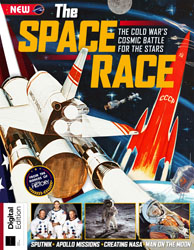|
Автор книги: Alice Barnes-Brown (Editor)
Серия: All About History
Издательство: Future Publishing
Год выпуска: 2019
Формат: PDF
Страниц: 148
Язык: английский
Размер: 138 Mb
Когда Нил Армстронг сделал первые шаги по поверхности Луны, он произнес знаменитую фразу: «Это один маленький шаг для человека и гигантский скачок для человечества». За этим событием лежали усилия сотен тысяч людей, которые каким-то образом способствовали успеху миссии. Но был и другой важный элемент - ожесточенное соперничество между США и СССР, которое бушевало на Земле.
То, что начиналось как создание нацистами ракет большой дальности, предназначенных для ударов по Европе, к концу 1950-х годов превратилось в технологическую гонку между величайшими сверхдержавами мира. Советский Союз удивил мир и начал космическую гонку, запустив спутник, который стал первым искусственным объектом, который был выведен на орбиту Земли. США должны были ответить - и с размахом.
В течение следующего десятилетия две страны боролись за космос, чтобы одержать важные победы друг над другом. Кульминацией гонки стала миссия НАСА «Аполлон-11» в 1969 году. Но космическая гонка на этом не закончилась - 1970-е годы открыли эру новых достижений, и даже сотрудничества между бывшими соперниками. На страницах этой книги вы узнаете о золотой эре освоения космоса, познакомитесь с космонавтами и их командами, насладитесь радостью успешной миссии и узнаете причины трагических катастроф. Наконец, загляните в будущее, чтобы увидеть, куда идет человечество.
When Neil Armstrong took those first, fateful steps on the surface of the Moon, he uttered the now-timeless phrase "that's one small step for man, one giant leap for mankind". His words may have sounded effortless, but the long-awaited mission to get to the moon was nothing short of astronomical.
Behind the quiet solitude of the moon lay the efforts of the hundreds of thousands of people, who had all contributed in some way to the mission's success. But there was also another important element - the fierce rivalry between the USA and the USSR that was raging back on Earth.
What began as a dark Nazi art of building long-range missiles, designed to rain down over Europe, had turned into a technological race between the world's greatest superpowers by the end of the 1950s. The Soviet Union had surprised the world and kicked off the race towards Space by launching Sputnik, the bare bones satellite that became the first man-made object to orbit Earth. The USA had to respond - and in a big way.
Over the next decade, the two countries battled it out to gain important victories over one another, culminating in NASA's Apollo 11 mission in 1969. But the Space Race didn't end there - the 1970s ushered in an era of new achievements, and even cooperation between the former rivals. Flick through the pages of this book to find out more about the golden era of Space exploration, get to know the astronauts and their teams, revel in the joy of a good mission and see what went wrong in tragic disasters. Finally, look into the future to see where mankind may put their footprint next. | 